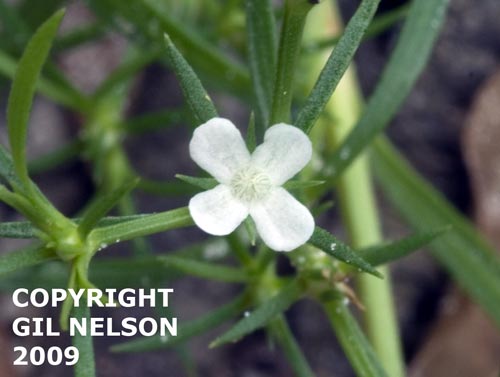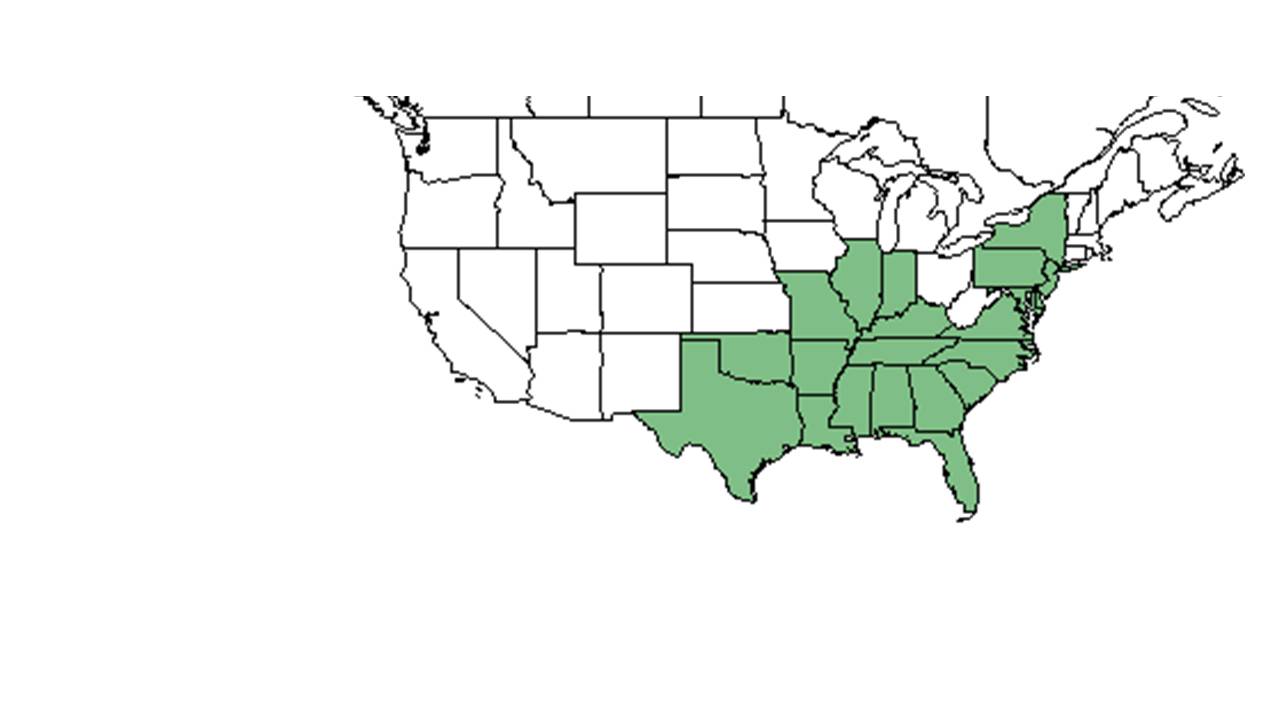Difference between revisions of "Polypremum procumbens"
(→Conservation and Management) |
Krobertson (talk | contribs) |
||
| Line 22: | Line 22: | ||
==Description== | ==Description== | ||
<!-- Basic life history facts such as annual/perrenial, monoecious/dioecious, root morphology, seed type, etc. --> | <!-- Basic life history facts such as annual/perrenial, monoecious/dioecious, root morphology, seed type, etc. --> | ||
| − | "Perennial, glabrous herb with radially ascending or repent branches from a central crown. Leaves opposite, linear, 1-2.5 cm long, 0.5-2 mm wide, acute. Inflorescence a terminal leafy cyme. Flowers actinomorphic, sessile or on pedicels less than 0.5 mm long. Calyx divided to near the base, teeth 4, subulate, 2-3 mm long; corolla divided 1/3 in length, 4-lobed, white, rotate; stamens 4, included. Capsule 1.5-2.5 mm long; seeds yellow, angulate, more or less square, microscopically pitted, 0.3-0.4 mm long." | + | "Perennial, glabrous herb with radially ascending or repent branches from a central crown. Leaves opposite, linear, 1-2.5 cm long, 0.5-2 mm wide, acute. Inflorescence a terminal leafy cyme. Flowers actinomorphic, sessile or on pedicels less than 0.5 mm long. Calyx divided to near the base, teeth 4, subulate, 2-3 mm long; corolla divided 1/3 in length, 4-lobed, white, rotate; stamens 4, included. Capsule 1.5-2.5 mm long; seeds yellow, angulate, more or less square, microscopically pitted, 0.3-0.4 mm long." <ref name="Radford et al 1964">Radford, Albert E., Harry E. Ahles, and C. Ritchie Bell. Manual of the Vascular Flora of the Carolinas. 1964, 1968. The University of North Carolina Press. 835. Print.</ref> |
==Distribution== | ==Distribution== | ||
==Ecology== | ==Ecology== | ||
===Habitat=== <!--Natural communities, human disturbed habitats, topography, hydrology, soils, light, fire regime requirements for removal of competition, etc.--> | ===Habitat=== <!--Natural communities, human disturbed habitats, topography, hydrology, soils, light, fire regime requirements for removal of competition, etc.--> | ||
| − | In the Coastal Plain in Florida and Georgia, ''P. procumbens'' can be found near streamlet crossings in open woodlands, well drained sandy soils of citrus furrows, annually burned savannas, sandy shores of karst ponds, annually burned longleaf pinelands, well drained uplands, and coastal dunes | + | In the Coastal Plain in Florida and Georgia, ''P. procumbens'' can be found near streamlet crossings in open woodlands, well drained sandy soils of citrus furrows, annually burned savannas, sandy shores of karst ponds, annually burned longleaf pinelands, well drained uplands, and coastal dunes. <ref name="FSU Herbarium">Florida State University Robert K. Godfrey Herbarium database. URL: [http://herbarium.bio.fsu.edu http://herbarium.bio.fsu.edu]. Last accessed: July 2015. Collectors: Loran C. Anderson, Cecil R Slaughter, Dianne Hall, R. A. Norris, R. Komarek, R. F. Doren, S. W. Leonard, J. Mickel, Thomas E. Miller, Robert K. Godfrey. States and Counties: Florida: Duval, Gadsden, Jefferson, Leon, Polk, St. Johns, Wakulla. Georgia: Grady, Thomas. Mexico. Compiled by Tall Timbers Research Station and Land Conservancy.</ref> It can also be found in compacted soils of roadways, frequently mowed lawns, and roadside depressions. Associated species include ''Lindernia, Murdannia, Kyllinga and Sida.'' <ref name="FSU Herbarium"/> |
| − | Soil types include loamy sand and moist loam | + | Soil types include loamy sand and moist loam. <ref name="FSU Herbarium"/> |
===Phenology=== <!--Timing off flowering, fruiting, seed dispersal, and environmental triggers. Cite PanFlora website if appropriate: http://www.gilnelson.com/PanFlora/ --> | ===Phenology=== <!--Timing off flowering, fruiting, seed dispersal, and environmental triggers. Cite PanFlora website if appropriate: http://www.gilnelson.com/PanFlora/ --> | ||
| − | Flowering and fruiting have been observed in July | + | Flowering and fruiting have been observed in July. <ref name="FSU Herbarium"/> |
===Seed dispersal=== | ===Seed dispersal=== | ||
| Line 40: | Line 40: | ||
<!--===Fire ecology===--> <!--Fire tolerance, fire dependence, adaptive fire responses--> | <!--===Fire ecology===--> <!--Fire tolerance, fire dependence, adaptive fire responses--> | ||
===Pollination=== | ===Pollination=== | ||
| − | The following Hymenoptera families and species were observed visiting flowers of ''Polypremum procumbens'' at Archbold Biological Station | + | The following Hymenoptera families and species were observed visiting flowers of ''Polypremum procumbens'' at Archbold Biological Station: <ref name="Deyrup 2015">Deyrup, M.A. and N.D. 2015. Database of observations of Hymenoptera visitations to flowers of plants on Archbold Biological Station, Florida, USA.</ref> |
Halictidae: ''Lasioglossum nymphalis'' | Halictidae: ''Lasioglossum nymphalis'' | ||
| Line 63: | Line 63: | ||
==References and notes== | ==References and notes== | ||
| − | |||
| − | |||
| − | |||
| − | |||
| − | |||
Revision as of 13:48, 8 August 2016
| Polypremum procumbens | |
|---|---|

| |
| Photo taken by Gil Nelson | |
| Scientific classification | |
| Kingdom: | Plantae |
| Division: | Magnoliophyta – Flowering plants |
| Class: | Magnoliopsida – Dicotyledons |
| Order: | Scrophulariales |
| Family: | Buddlejaceae |
| Genus: | Polypremum |
| Species: | P. procumbens |
| Binomial name | |
| Polypremum procumbens L. | |

| |
| Natural range of Polypremum procumbens from USDA NRCS Plants Database. | |
Common name: juniper leaf
Contents
Taxonomic notes
Description
"Perennial, glabrous herb with radially ascending or repent branches from a central crown. Leaves opposite, linear, 1-2.5 cm long, 0.5-2 mm wide, acute. Inflorescence a terminal leafy cyme. Flowers actinomorphic, sessile or on pedicels less than 0.5 mm long. Calyx divided to near the base, teeth 4, subulate, 2-3 mm long; corolla divided 1/3 in length, 4-lobed, white, rotate; stamens 4, included. Capsule 1.5-2.5 mm long; seeds yellow, angulate, more or less square, microscopically pitted, 0.3-0.4 mm long." [1]
Distribution
Ecology
Habitat
In the Coastal Plain in Florida and Georgia, P. procumbens can be found near streamlet crossings in open woodlands, well drained sandy soils of citrus furrows, annually burned savannas, sandy shores of karst ponds, annually burned longleaf pinelands, well drained uplands, and coastal dunes. [2] It can also be found in compacted soils of roadways, frequently mowed lawns, and roadside depressions. Associated species include Lindernia, Murdannia, Kyllinga and Sida. [2]
Soil types include loamy sand and moist loam. [2]
Phenology
Flowering and fruiting have been observed in July. [2]
Seed dispersal
According to Kay Kirkman, a plant ecologist, this species disperses by gravity. [3]
Pollination
The following Hymenoptera families and species were observed visiting flowers of Polypremum procumbens at Archbold Biological Station: [4]
Halictidae: Lasioglossum nymphalis
Megachilidae: Megachile brevis pseudobrevis
Sphecidae: Cerceris blakei, Microbembex monodonta
Vespidae: Stenodynerus fundatiformis
Use by animals
Deyrup observed this bee, Dialictus nymphalis, on P. procumbens.[5] Cover of P. procumbens decreased significantly through time after three grazing treatments (no grazing by deer or cattle, grazing by deer, or grazing by deer and cattle) in thinned and clearcut forested areas. [6]
Conservation and management
Cultivation and restoration
Photo Gallery
References and notes
- ↑ Radford, Albert E., Harry E. Ahles, and C. Ritchie Bell. Manual of the Vascular Flora of the Carolinas. 1964, 1968. The University of North Carolina Press. 835. Print.
- ↑ 2.0 2.1 2.2 2.3 Florida State University Robert K. Godfrey Herbarium database. URL: http://herbarium.bio.fsu.edu. Last accessed: July 2015. Collectors: Loran C. Anderson, Cecil R Slaughter, Dianne Hall, R. A. Norris, R. Komarek, R. F. Doren, S. W. Leonard, J. Mickel, Thomas E. Miller, Robert K. Godfrey. States and Counties: Florida: Duval, Gadsden, Jefferson, Leon, Polk, St. Johns, Wakulla. Georgia: Grady, Thomas. Mexico. Compiled by Tall Timbers Research Station and Land Conservancy.
- ↑ Kay Kirkman, unpublished data, 2015.
- ↑ Deyrup, M.A. and N.D. 2015. Database of observations of Hymenoptera visitations to flowers of plants on Archbold Biological Station, Florida, USA.
- ↑ Deyrup, M. J. E., and Beth Norden (2002). "The diversity and floral hosts of bees at the Archbold Biological Station, Florida (Hymenoptera: Apoidea)." Insecta mundi 16(1-3).
- ↑ Brockway, D. G. and C. E. Lewis (2003). "Influence of deer, cattle grazing and timber harvest on plant species diversity in a longleaf pine bluestem ecosystem." Forest Ecology and Management 175: 49-69.